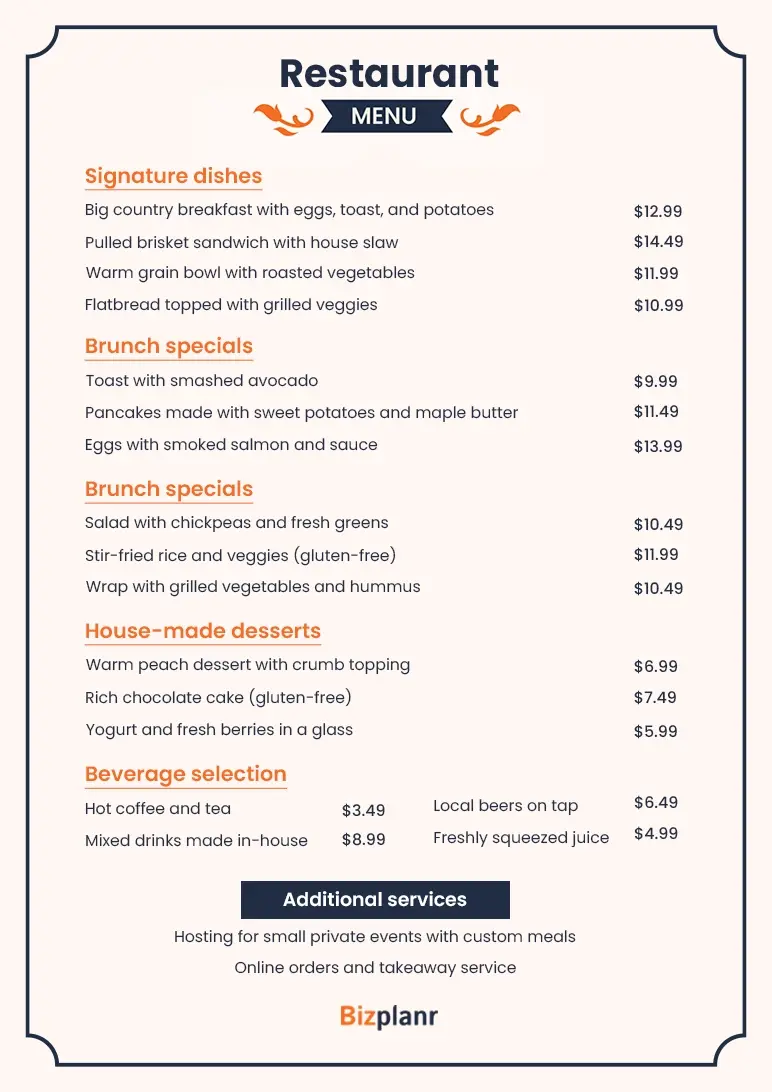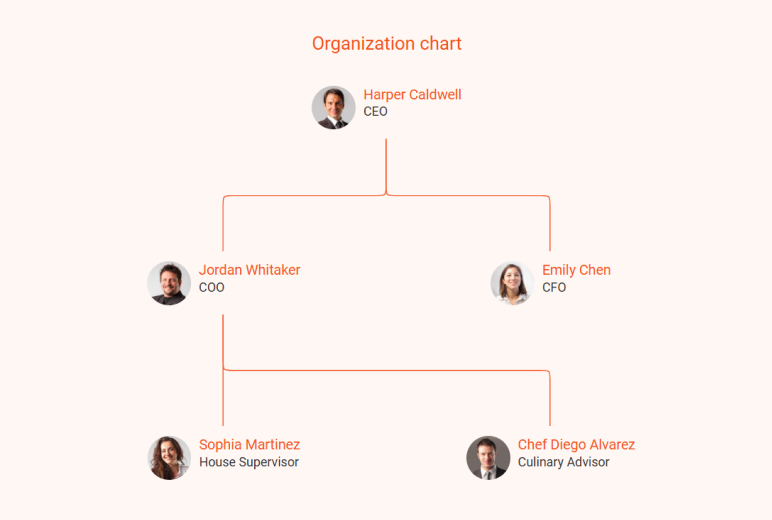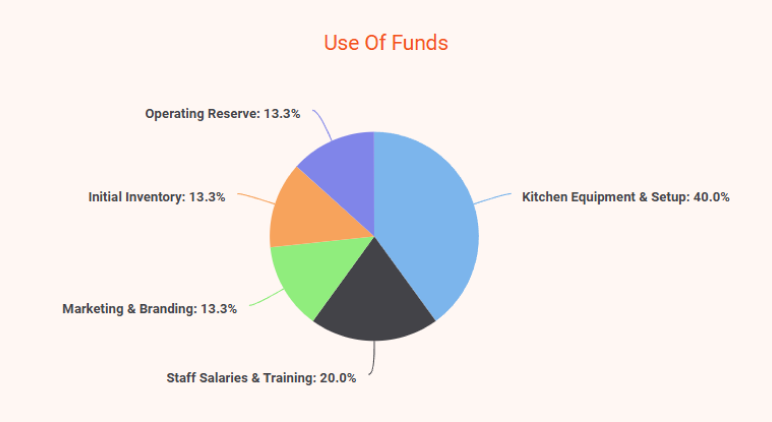Starting a restaurant? It’s an exciting journey where your passion for food and great service can grow into a thriving business. But before you start serving meals or finalizing your menu, you need a clear plan to guide you.
Without one, it’s easy to get overwhelmed by costs, competition, and unexpected challenges.
Need help writing your plan in order?
Worry not! This restaurant business plan sample will walk you through each section so you can draft your plan with confidence.
Restaurant Business Plan Sample
Let’s walk through the SavorNest Kitchen business plan sample to better understand the key elements you should include while writing your own plan.
1. Executive Summary
Savornest Kitchen is a modern American restaurant located in the center of Austin, Texas. Our menu together brings classics and fresh, locally sour materials together to make delicious food that feels both familiar and new.
We serve breakfast, brunch, lunch, and dinner options for all tastes, including vegetarian, vegan, and gluten-free dishes. The restaurant provides a comfortable, welcoming location for young professionals, families, food lovers, and visitors in Austin.
With our dine-in experience, we also provide takeouts, online ordering, and private event hosting. From the food of the week to the weekend to the weekend, Savorn is all about good food, hot service, and bringing the community together.
Target Market
At SavorNest Kitchen, we aim to serve a wide mix of customers who appreciate good food and a welcoming space. Our main audience includes:
- Young professionals and business people, looking for quality meals and a comfortable atmosphere to relax or meet over lunch.
- Families who enjoy casual yet elevated dining experiences that are kid-friendly and full of flavor.
- Food lovers and culinary enthusiasts who seek creative dishes made with fresh, local ingredients.
- Tourists exploring Austin, eager to experience the city’s vibrant food culture in a stylish, local spot.
- Health-conscious diners are interested in farm-to-table meals with vegan, vegetarian, and gluten-free options.
- Corporate clients booking private dining or events where great food and service matter.
Unique Selling Propositions (USPs)
So, what sets us apart? Every plate starts with fresh, local produce and changes with the seasons. From house-made pies to the craft cocktails that cap the night, our team stirs, whips, and garnishes by hand. For busy days, we keep takeout and online ordering smooth, plus full-service catering and packages for private gatherings.
Marketing Strategy
We'll reach out to customers on social media like Instagram, Facebook, and TikTok. We'll post updates and deals there. We'll also team up with food bloggers in the area, send out newsletters each month, and set up events to bring people together. A program for loyal customers will encourage them to keep coming back.
Financial Highlights
We need $750,000 in funding. This cash will help us get our restaurant up and running. We'll use it for fixing up the place, buying kitchen gear, setting up a website, bringing on staff, kicking off our marketing, and covering our costs for the first six months.
The table below presents a three-year financial projection, highlighting our expected revenue growth, cost management, and overall profitability.
| Category | Year 1 | Year 2 | Year 3 |
|---|---|---|---|
| Total Revenue | $500,000 | $665,000 | $850,000 |
| COGS | $170,000 | $215,000 | $260,000 |
| Gross Profit | $330,000 | $450,000 | $590,000 |
| Operating Expenses | $200,000 | $234,000 | $268,000 |
| Net Profit | $130,000 | $216,000 | $322,000 |
Liking the plan you're reading? It's AI generated.
Generate Your Own Using Bizplanr AI
2. Business Description
SavorNest Kitchen is located at 4827 Willow Creek Blvd, Austin, Texas. It was founded by Harper Caldwell, a food and community enthusiast. The concept behind SavorNest is a simple one—a quaint place where good people gather to eat freshly prepared food with a homely yet refreshingly modern twist. We’ll open for breakfast, brunch, lunch, and dinner, and there will be lots of options, including vegan, vegetarian, and gluten-free.
Mission Statement
Our goal is to provide a wholesome meal with the freshest local ingredients served in a welcoming environment that feels like home. We want every guest to leave feeling satisfied, appreciated, and a little more connected to the community.
Vision Statement
We desire to be the neighborhood favorite, where locals come for fresh food, good vibes, and our support of local farmers and local businesses. We want to be that place where memories are formed, from casual lunches to weekend brunches and everything in between.
Future Goals
Going forward, we would like to increase the size of our team and further develop relationships with local farms and suppliers. We also would like to offer a broader range of services and include more community events, special menus, and hopefully grow into other locations.
Our bottom line is to continue to push forward and evolve while remembering who we are: A restaurant that values good food, good people, and a good time.
3. Industry and Market Research
The restaurant industry in Austin is buzzing, with people always on the lookout for great places to eat. More folks are choosing fresh, locally sourced meals, and there's a growing interest in casual yet high-quality dining. This gives SavorNest Kitchen a great opportunity to stand out and attract a loyal following.
On a broader scale, the U.S. food service market size was valued at $824.61 billion in 2022 and is projected to grow from $905.13 billion in 2023 to $1,767.54 billion by 2030, showing a CAGR of 10.03% during the forecast period.
Target Market
We’ve got a pretty diverse group of people we want to serve, and each one has different reasons for walking through our doors.
- Young professionals in search of a chill but good quality place for meals or meetups
- Families seeking an informal environment with incredible food and kid-friendly energy
- Tourists who are looking to try the local fare and get a taste of Austin’s culinary scene
- Diners who are health-conscious and value fresh, locally sourced food
Competitor Analysis
Austin is BLESSED with too many amazing things to eat, so we spent some time thinking about who we’re up against and what they do well.
- Snooze, an A.M. Eatery – Snooze is a vibrant place, well-known for its whimsical and playful breakfast and brunch selections. It has a large morning crowd, especially on weekends.
- Jacoby’s Restaurant & Mercantile – A rustic, Texas-vibes spot with a Southern menu at Jacoby’s Restaurant& Mercantile. It’s a favorite among those who love comfort food in a more casual setting.
- Elizabeth Street Café – This café is unique with its French and Vietnamese fusion of flavors. Clad in a playful decor and with an unusual menu
SWOT Analysis
4. Sample Menu
Here’s a sneak peek at the kind of food we love to serve—fresh, flavorful, and thoughtfully prepared. This sample menu offers a glimpse of what guests can look forward to when they dine at SavorNest Kitchen.
5. Marketing Strategy
In the SavorNest kitchen, we not only want to serve magnificent food, but also develop strong, meaningful relations with our guests.
We’ve developed a marketing strategy that mixes digital outreach and real-world community connections, making it easier for us to reach the right audience and bring them back through the door.
To connect and grow with our community, we plan to use a mix of online platforms and local events that help create awareness and customer loyalty.
Digital Marketing
Our perspectives for online visibility and customer engagement include the following:
- Social media content: To keep people excited, we’ll post eye-catching food photos, short videos, and daily special posts on social media.
- Website experience: Our website will be mobile-friendly and easy to navigate, featuring our full menu and online ordering.
- Local listing: We’ll update our Google business profile to promote visibility and make it easy to find for new customers.
- Email marketing: Monthly email newsletters will provide updates, seasonal specials, and special offers.
Community Engagement
Here’s how we’ll connect with the local community and build relationships:
- Local programs: Food taste, brunch, and pop-up dinner will bring people together.
- Partnership: Cooperation with local schools, farms, and donations will enable us to give back and create confidence.
- Community visibility: By joining community festivals and fairs, we’ll be allowed to meet new people.
- Support for creative: Local talents will also be supported through live music or local art performances. Promotion and loyalty program
Promotions and Loyalty Programs
Several ways we plan to reward our guests and keep them coming back:
- Welcome offers: First-time customers will get a welcome discount. This will encourage them to return.
- Loyalty points: Our loyalty program will let us reward returning guests with points that turn into free items.
- Seasonal specials: Special seasonal deals like “2-for-1 Tuesdays” or “Dessert on Us” nights will run regularly.
- Birthday rewards: We'll celebrate customer birthdays with a free treat or discount to make them feel appreciated.
Targeted Advertising
Here’s how we’ll use advertising to reach potential customers effectively:
- Local targeting: We'll run social media ads focusing on people who live or work near the restaurant.
- Promotional focus: Ads will highlight our best dishes and promos to attract families, professionals, and food lovers.
- Search ads: We’ll also place targeted Google ads so we show up when people search for places to eat in Austin.
- Seasonal campaigns: Seasonal ad campaigns will promote special menus and limited-time events.
6. Operations Plan
Running a restaurant takes more than just good food—it requires thoughtful planning, clear routines, and a reliable team. At SavorNest Kitchen, our operations are designed to deliver quality meals and great service every single day.
Daily Operations
- Opening starts with team check-ins, assigning stations, turning on equipment, and prepping ingredients.
- During service, we monitor food quality, manage wait times, and ensure clear communication among the kitchen and front-of-house staff.
- Midday downtime is used for cleaning, prep for dinner, and reviewing staff notes to adjust operations.
- Closing involves deep cleaning the kitchen, logging sales, reviewing inventory, and preparing for the next day.
Staffing & Training
- The team includes line cooks, sous chefs, a host, a bartender, and a cleaning crew.
- Training focuses on customer service, food safety, allergy awareness, and emergency response.
- Cross-training helps staff cover multiple roles during peak times or shortages.
- Weekly meetings help us stay aligned on feedback, service goals, and any changes to the menu or process.
Inventory Tools
- We’ll use a simple POS-integrated system that tracks ingredient usage, supplier schedules, and makes sure we always have the right amount of stock on hand.
- Food is labeled with prep dates to support first-in, first-out stock rotation.
- We’ll run daily fridge and pantry checks to monitor freshness and avoid spoilage.
- Reports from the inventory system will guide our reordering and help cut down on waste and over-purchasing.
Location and Facilities
- We’re based at 4827 Willow Creek Boulevard in Austin, Texas, surrounded by both residential and commercial foot traffic.
- The restaurant includes a welcoming dining area, a covered patio, a professional-grade kitchen, and ample storage.
- We maintain clean restrooms, a staff break space, and a separate entry for deliveries and suppliers.
- Accessibility is key—our layout is designed to be inclusive and easy for guests to move through comfortably.
7. Management Team
At SavorNest Kitchen, we’ve brought together a group of passionate and skilled professionals who know food, service, and business. Each team member plays a key role in making sure everything runs smoothly, from the kitchen to the front counter.
Key Managers
Harper Caldwell – Owner & CEO
Harper is the heart behind SavorNest. With a strong background in hospitality and a love for fresh, seasonal cooking, Harper oversees the big picture—from shaping the menu to growing the brand. Harper ensures the restaurant stays true to its mission and delivers a great experience every day.
Jordan Whitaker – Operations Manager
Jordan keeps the day-to-day operations on track. From staff scheduling and inventory checks to customer service and quality control, Jordan makes sure every shift runs like clockwork. Jordan’s leadership keeps both the team and guests happy.
Emily Chen – Finance Manager
Emily oversees all financial operations. She manages the budget, monitors daily sales, handles payroll, and makes sure bills are paid on time. Emily’s financial planning keeps us sustainable and ready for growth.
Sophia Martinez – Front-of-House Supervisor
Sophia is our go-to person for everything guest-facing. She trains waiters and hosts, manages the front-of-house team, and handles guest concerns quickly and professionally.
Together, this team forms a strong foundation built on collaboration, experience, and a shared passion for good food and great service.
Organization Chart
8. Financial plan
A solid financial plan helps us stay on track, prepare for the unexpected, and grow at a steady pace.
Below are the key areas we’ve considered to make sure SavorNest Kitchen is both sustainable and successful.
Profit and Loss Statement
This table breaks down what we expect to earn and spend over the next three years, giving a clear view of our income and profit margins. This table breaks down our expected income, costs, and profits for the first three years in detail.
| Category | Year 1 ($) | Year 2 ($) | Year 3 ($) |
|---|---|---|---|
| Revenue | |||
| In-Store Sales | $200,000 | $400,000 | $500,000 |
| Catering & Events | $100,000 | $150,000 | $150,000 |
| Online Orders | $70,000 | $75,000 | $100,000 |
| Beverage Sales | $60,000 | $80,000 | $75,000 |
| Merchandise & Gift Cards | $70,000 | $70,000 | $25,000 |
| Total Revenue | $500,000 | $665,000 | $850,000 |
| Cost of Goods Sold | |||
| Food Ingredients | $120,000 | $180,000 | $190,000 |
| Beverage Supplies | $25,000 | $25,000 | $26,000 |
| Packaging | $10,000 | $12,000 | $20,000 |
| Miscellaneous Costs | $15,000 | $8,000 | $24,000 |
| Total COGS | $170,000 | $225,000 | $260,000 |
| Gross Profit | $330,000 | $440,000 | $590,000 |
| Operating Expenses | |||
| Rent | $60,000 | $60,000 | $60,000 |
| Salaries and Wages | $100,000 | $120,000 | $160,000 |
| Marketing | $20,000 | $40,000 | $50,000 |
| Utilities | $10,000 | $10,000 | $10,000 |
| Maintenance & Repairs | $8,000 | $10,000 | $12,000 |
| Miscellaneous Expenses | $2,000 | $4,000 | $6,000 |
| Total Operating Exp. | $200,000 | $244,000 | $298,000 |
| Net Profit | $130,000 | $196,000 | $292,000 |
Cash Flow Statement
Cash flow tells us how money will move in and out of the business. It helps us stay prepared to cover everyday costs while planning for growth. Here’s a more detailed look at the money coming in and going out of the business.
| Category | Year 1 (USD) | Year 2 (USD) | Year 3 (USD) |
|---|---|---|---|
| Opening Balance | $0 | $100,000 | $150,000 |
| Cash Inflows | |||
| Revenue from Sales | $500,000 | $665,000 | $850,000 |
| Other Income | $50,000 | $60,000 | $75,000 |
| Total Cash In | $550,000 | $725,000 | $925,000 |
| Cash Outflows | |||
| Operating Expenses | $200,000 | $244,000 | $298,000 |
| COGS | $170,000 | $225,000 | $260,000 |
| Equipment & Setup | $70,000 | $40,000 | $70,000 |
| Marketing & Promotions | $20,000 | $40,000 | $50,000 |
| Miscellaneous | $0 | $10,000 | $17,000 |
| Total Cash Out | $460,000 | $559,000 | $695,000 |
| Ending Balance | $100,000 | $166,000 | $230,000 |
Balance Sheet
This shows what we own, what we owe, and what’s left over at the end of each year. It’s a snapshot of our business’s financial health. Below is a breakdown of what we own (assets), owe (liabilities), and what’s left (equity).
| Category | Year 1 (USD) | Year 2 (USD) | Year 3 (USD) |
|---|---|---|---|
| Assets | |||
| Cash | $50,000 | $130,000 | $200,000 |
| Inventory | $40,000 | $50,000 | $60,000 |
| Equipment | $200,000 | $200,000 | $200,000 |
| Prepaid Expenses | $5,000 | $7,000 | $9,000 |
| Accounts Receivable | $10,000 | $15,000 | $20,000 |
| Total Assets | $305,000 | $402,000 | $489,000 |
| Liabilities | |||
| Loans Payable | $100,000 | $90,000 | $80,000 |
| Accounts Payable | $80,000 | $90,000 | $100,000 |
| Accrued Expenses | $15,000 | $17,000 | $19,000 |
| Total Liabilities | $195,000 | $197,000 | $199,000 |
| Retained Earnings | $60,000 | $90,000 | $120,000 |
| Owner's Equity | $50,000 | $115,000 | $170,000 |
| Total Equity | $110,000 | $205,000 | $290,000 |
Funding Requirements
We’re seeking $750,000 to help cover startup costs and support operations during the first six months. Here's a detailed breakdown of how the funds will be used:
| Use of Funds | Amount (USD) |
|---|---|
| Kitchen Equipment & Setup | $300,000 |
| Staff Salaries & Training | $150,000 |
| Marketing & Branding | $100,000 |
| Initial Inventory | $100,000 |
| Operating Reserve | $100,000 |
| Total | $750,000 |
Download a Free Restaurant Business Plan Template
Ready to create your restaurant business plan but not sure where to start? We’re here to help! Download our free restaurant business plan template (PDF) and take the first step toward opening your dream restaurant.
This easy-to-use and investor-friendly template includes clear instructions, helpful examples, and sections designed just for restaurants. Whether you’re planning a casual café or a full-service dining spot, you can easily customize the plan to fit your unique concept.
Conclusion
Now that you’ve seen how each part of a restaurant business plan fits together, putting your own plan in place should feel much more manageable.
Still unsure about the details or looking for extra support? Try our AI-powered business plan tool—Bizplanr. It’s designed to guide you step-by-step and make planning simple.
Just answer a few easy questions and get your complete restaurant business plan in minutes!
Get Your Business Plan Ready In Minutes
Answer a few questions, and AI will generate a detailed business plan.
Frequently Asked Questions
How do I write financial projections for a restaurant business plan?
Start by estimating how many customers you’ll serve each day and how much they’re likely to spend. Then factor in your regular costs—like rent, staff pay, food and drink supplies, utilities, and marketing. Use that info to create key financial projections such as an income statement, cash flow forecast, balance sheet, and a break-even analysis to understand when your restaurant will start making a profit.
What should I include in a restaurant business plan?
A good restaurant business plan should include:
- A brief executive summary
- A description of your restaurant and concept
- Details about your target customers and competitors
- The menu or services you’ll offer
- Your marketing and sales plan
- Daily operations
- A clear financial plan with funding needs
How much does it cost to write a restaurant business plan?
The cost can vary a lot. If you write it yourself using free tools, it can cost nothing. If you hire a professional, it might range from a few hundred dollars to several thousand, depending on how detailed it needs to be and the help you want.
Why is a marketing strategy important in a restaurant business plan?
Marketing is how you get people in the door. A good restaurant marketing strategy helps you spread the word, build your restaurant’s brand, and stay top of mind for customers. It’s especially important in competitive areas where food flavours have lots of options.










